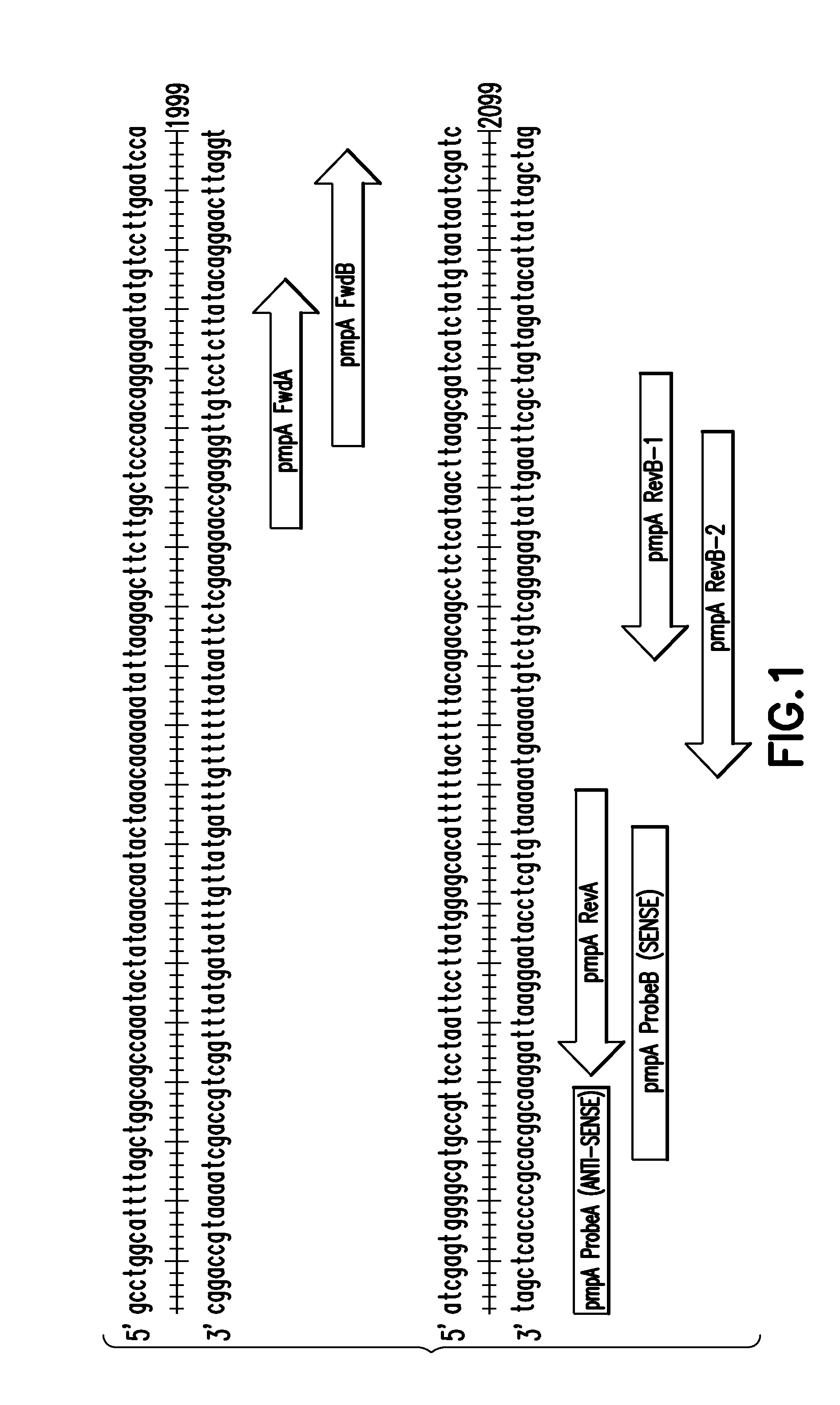Assay for chlamydia trachomatis by amplification and detection of chlamydia trachomatis pmpa gene
- Summary
- Abstract
- Description
- Claims
- Application Information
AI Technical Summary
Benefits of technology
Problems solved by technology
Method used
Image
Examples
Example
Example 1
C. trachomatis Target Region Positive Control
[0056]A 342 base pair DNA fragment that is 100% identical to nucleotides 1835-2176 of the pmpA gene from C. trachomatis serovar H, strain UW-4 was synthesized de novo. The fragment was ligated into the vector Blue Heron Bio pUC (Blue Heron Biotechnology) and the recombinant plasmid, CTpmpA, was transformed into SC110 competent cells (Stratagene catalog number 200247). Plasmid DNA was purified from the SCS110 competent cells through a cesium chloride gradient and linearized by digestion with EcoR1 enzyme (Roche catalog number 10200310001). The purified plasmid DNA was quantified by UV spectrophotometry. The resulting DNA fragment was used as a positive control in several of the following Examples.
Example
Example 2
Functional Performance of pmpA Assay A
[0057]Various amounts of the CTpmpA plasmid were used to test the functionality of the pmpA Assay A. The range of concentrations of the CTpmpA plasmid included 1×106, 1×105, 1×104, 1×103, 100, and 10 copies per reaction. Four replicates were tested at each target concentration, as well as four no-template replicates as a negative control. For each replicate, CTpmpA recombinant plasmid containing C. trachomatis target DNA was diluted in 5 mM Tris pH 8.0. The diluted plasmid was then added to the wells of a 96-well microtiter plate containing TaqMan® Universal PCR Master Mix (Applied Biosystems catalog number 43021437), 900.0 nM pmpA FwdA (SEQ. ID NO. 10), 900.0 nM pmpA RevA (SEQ ID NO. 11), and 250.0 nM pmpA ProbeA (SEQ ID NO. 12). Real-time PCR amplification and detection was performed using the ABI 7500 sequence detection system (Applied Biosystems). The thermal cycling profile was: Cycle 1 at 50° C. for 2 minutes followed by 95° C. fo...
Example
Example 3
Functional Performance of pmpA Assay B
[0059]Various amounts of the CTpmpA plasmid were used to test the functionality of the pmpA Assay B. The range of concentrations of CTpmpA plasmid included 1×106, 1×105, 1×104, 1×103, 100, and 10 copies per reaction. Four replicates were tested at each target concentration, as well as four no-template replicates as a negative control. For each replicate, CTpmpA recombinant plasmid containing C. trachomatis target DNA was diluted in 5 mM Tris pH 8.0. The diluted plasmid was then added to the wells of a 96-well multi-well microtiter plate containing TaqMan® Universal PCR Master Mix (Applied Biosystems catalog number 4304437), 900.0 nM pmpA FwdB (SEQ. ID NO. 13), 900.0 nM pmpA RevB-2 (SEQ ID NO. 16), and 250.0 nM pmpA ProbeB (SEQ ID NO. 15). Real-time PCR amplification and detection was performed using the ABI 7500 sequence detection system (Applied Biosystems). The thermal cycling profile was: Cycle 1 at 50° C. for 2 minutes followed by 9...
PUM
| Property | Measurement | Unit |
|---|---|---|
| Temperature | aaaaa | aaaaa |
| Temperature | aaaaa | aaaaa |
| Fraction | aaaaa | aaaaa |
Abstract
Description
Claims
Application Information
 Login to view more
Login to view more - R&D Engineer
- R&D Manager
- IP Professional
- Industry Leading Data Capabilities
- Powerful AI technology
- Patent DNA Extraction
Browse by: Latest US Patents, China's latest patents, Technical Efficacy Thesaurus, Application Domain, Technology Topic.
© 2024 PatSnap. All rights reserved.Legal|Privacy policy|Modern Slavery Act Transparency Statement|Sitemap

